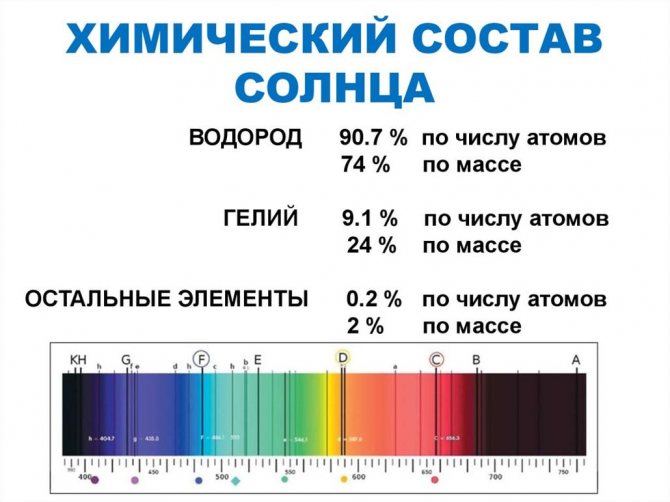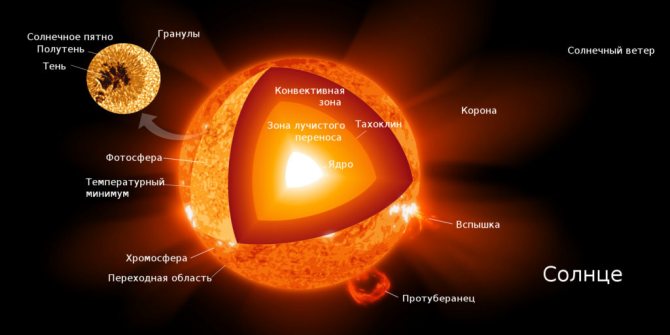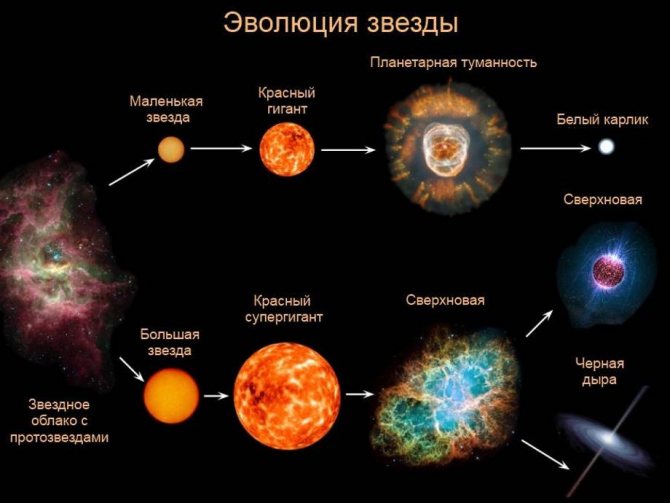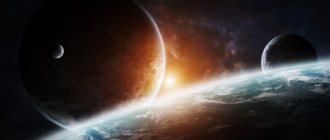Fact No. 1
The Sun is the Solar System as a whole. How can this be, because the system that is part of the galaxy is a system of planets, and the Sun is just a star, albeit the most central one. It would seem that the objects are completely different. Still, one has only to look at the Solar System in terms of its mass, and one can immediately see that the Sun occupies 98% of the total mass of the system in which humanity lives. The remaining 2% were divided to one degree or another by the 8 planets in the system, including the Earth. The lion's share of the mass is occupied by Jupiter and Saturn, the so-called “Gas Giants”. The Earth's share of the entire system accounts for an incredibly tiny mass by cosmic standards.
What is the Sun made of?
In terms of its chemical composition, our luminary is no different from other stars and contains: 74.5% hydrogen (by mass), 24.6% helium, less than 1% other substances (nitrogen, oxygen, carbon, nickel, iron, silicon, chromium, magnesium and other substances). Inside the core there are continuous nuclear reactions that convert hydrogen into helium. The absolute majority of the mass of the Solar System - 99.87% belongs to the Sun.

Interesting fact : The Sun has an almost perfect spherical shape. The difference in diameters connecting opposite points of the equator and poles is 10 kilometers. And this despite its gigantic size!
Fact No. 6

The sun is a multi-layered star. The visible surface of a star is only its outer layer. It is called the photosphere. The temperature on it can reach 5700 Kelvin or 15561000C, because one Kelvin is equal to 2730C.
Then, at around 70% of the solar diameter, there is a layer called “convection”. Next is a zone called "Radiant Transfer". The center of the star is the nucleus. Its temperature reaches values of at least 16,000,0000C. It now becomes clear that the solar surface is not the hottest place not only on the star, but also in the solar system as a whole.
Characteristics of the Sun
The sun has the following parameters:
- Age –4.57 billion years;
- Distance to Earth: 149,600,000 km
- Mass: 332,982 Earth masses (1.9891·10³⁰ kg);
- The average density is 1.41 g/cm³ (it increases 100 times from the periphery to the center);
- The orbital speed of the Sun is 217 km/s;
- Rotation speed: 1.997 km/s
- Radius: 695-696 thousand km;
- Temperature: from 5,778 K at the surface to 15,700,000 K at the core;
- Corona temperature: ~1,500,000 K;
- The Sun is stable in its brightness, it is in the 15% of the brightest stars in our Galaxy. It emits less ultraviolet rays, but has more mass compared to similar stars.
Fact No. 7
For centuries, religion refused to acknowledge the rotation of our planet around the sun. Religious leaders and their followers considered our planet to be the center of all things. It got to the point that in 1633, a physicist named Galileo Galilei was condemned for his public support of the system of the universe put forward by Nicolaus Copernicus, who argued that the planet revolved around a star. The church considered this theory to be a theory of heretics since 1616. As a result, Galileo was imprisoned for life. Later, they took pity on him, and life imprisonment was replaced by house arrest, but under the tireless eye of the Inquisition.
The church openly acknowledged that the Earth rotates around the sun in 1992. This was done by none other than the famous John Paul II. The Pope went further and admitted that Galileo's trial was wrong, calling it a "tragic misunderstanding."
Life cycle of the Sun
Apparently, the Sun owes its appearance to protostars of previous generations, since it contains a significant amount of metals. Its age is 4.5 -4.75 billion years, and all this time it increases its brightness and temperature (flares up).

Life cycle of stars
Interesting fact: the magnetic field of our star has a cycle of change approximately equal to 22 Earth years. Which is equal to two periods of solar activity in 11 years.
Such a physical process cannot occur without loss of mass of hydrogen, which is the main element in the composition of the star. Someday this will end, the hydrogen will burn and evaporate, and the helium will begin to shrink. The size of the star will increase until it reaches the limits of the Earth's orbit. The Sun will become a red giant and will remain in this state for approximately 120 million years. Then a nebula will appear due to a significant decrease in mass and a gigantic expansion of the outer layer. It will change from a red giant to a white dwarf, which will turn black in a few trillion years.
Interesting: Stars











